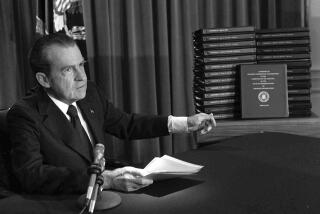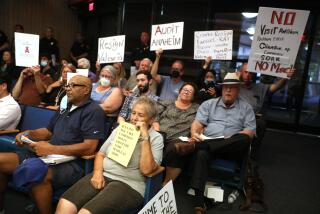Congress Had Better Pay Now or It Will Pay Later : Why campaign finance reform could prove a lot better than term limits
- Share via
President Clinton’s economic stimulus package has fallen to Republican filibuster and White House mishandling. His deficit reduction package and with it much of his domestic agenda, according to some of his closest allies, are in growing danger. But the real turning point in his presidency may be at hand with the prediction by Senate Minority Leader Bob Dole (R-Kan.) that S3, the Senate bill that contains the President’s campaign financing reform, will also be stopped by Republican filibuster. There is every reason to believe that prediction.
The stalemate of Clinton’s first hundred days has amply demonstrated that reform is not made by a reformist mood alone. During the presidential campaign, candidate Ross Perot said that the federal jalopy was broke and he was going to get under the hood and fix it. Candidate Clinton agreed and, after his victory, brought his own less radical program of economic stimulus, deficit reduction and campaign financing reform to Washington. But 100 days later, the mood the two of them generated has dissipated; and if nothing changes, the 100-day stalemate may well grow into a four-year stalemate, duplicating the stalemate of the Bush Administration.
THE INADVERTENT SELF-DESTRUCTIVENESS OF THE SYSTEM: The presidential veto and the Senate filibuster are two mechanisms that slow or stop the federal government process. Added to these has been the effect of political contributions: What a contributor’s check buys, when it can’t buy the contributor’s own agenda, is the frustration of an opponent’s agenda. But the difference between the Constitution’s checks and balances in the federal government and paid-for gridlock is like that between immunity and auto-immunity. Money, the HIV virus of politics, tricks the system into destroying itself.
Campaign financing reform can change this, but campaign financing reform is a matter of rallying the incumbents against themselves. Few and fleeting are the moments when this can be done. When a president is new on the job--when, briefly, the prestige of his office can be cashed in for a few legislative votes--is perhaps the only such moment that recurs. As soon as the honeymoon ends, the difference between incumbent and challenger quickly swamps the difference between Republican and Democrat.
The current system of campaign financing overwhelmingly favors incumbents. S3, like the vetoed bills that preceded it in 1990, 1991 and 1992, would establish spending limits, provide public campaign resources for congressional races, limit the influence of political action committee money and end money-laundering abuses.
GROWING THREAT OF TERM LIMITS: The public interest group Common Cause reports that in 1992, 12 Republican incumbents outspent their Democratic challengers by an average of $5,553,270 to $2,563,938. Sixteen Democratic incumbents outspent their Republican challengers by an average of $3,487,518 to $1,158,425. In 1992, Sen. Dole himself raised $3,115,690 ($1,564,722 from political action committees); his opponent, Democrat Gloria O’Dell, raised a paltry $246,056 ($40,150 from PACs). O’Dell may have had trouble raising money because Dole was a shoo-in. But then, one must ask, why would contributors spend good money on a shoo-in? Not, you may be sure, to shoo him in.
Unless and until congressional term limits are imposed, the Republican support for incumbent protection is, ironically, a key factor in returning Democratic majorities in election after election. But if Democratic support for incumbent protection is hastening the day when term limits are indeed imposed, then that support may be shortsighted.
Campaign finance reform is the one effective alternative to term limits. If it fails this time, as it well may, and if frustration builds in the electorate over the remainder of Clinton’s term as it did during George Bush’s, term limits may be all but inevitable.
More to Read
Get the L.A. Times Politics newsletter
Deeply reported insights into legislation, politics and policy from Sacramento, Washington and beyond. In your inbox twice per week.
You may occasionally receive promotional content from the Los Angeles Times.










